Release Date :
Reference Number :
2015-020
Three in five persons aged 15 years and over were in the labor force
The population 15 years old and over in October 2014 was estimated at 64.3 million (Table 1). Of this number, 41.3 million were in the labor force (Table 2 and Table 3). The labor force consists of the employed and the unemployed persons. The labor force participation rate (LFPR) in October 2014 was estimated at 64.3 percent. The LFPR for October 2013 was 63.9 percent. Among the regions, Northern Mindanao (Region X) had the highest LFPR at 71.0 percent, while Autonomous Region in Muslim Mindanao (ARMM) had the lowest at 56.9 percent.
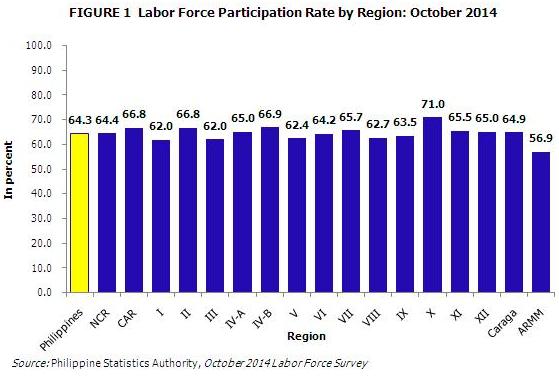
Employment rate recorded at 94.0 percent
The number of employed persons in October 2014 was estimated at 38.8 million (Table 2). This translates to an employment rate of 94.0 percent (Table 1). The employment rate in October 2013 was 93.6 percent.
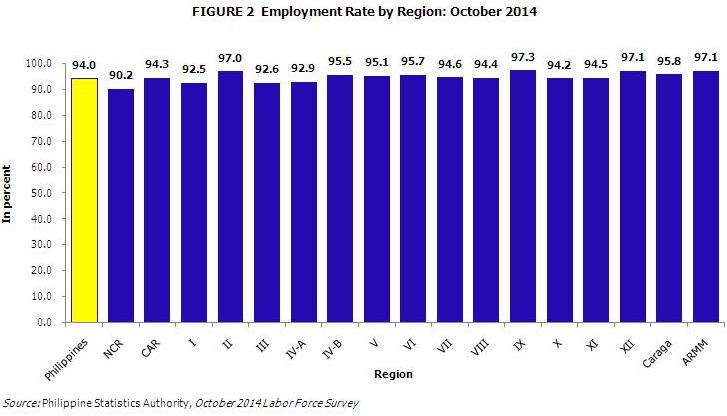
Among the regions, the National Capital Region (NCR) had the lowest employment rate in October 2014 at 90.2 percent (Table 1). Three other regions, namely, Ilocos Region (92.5%), Central Luzon (92.6%), and CALABARZON (92.9%), likewise had rates lower than the national figure.
One in four employed persons in the age group 25 to 34 years
Of the 38.8 million employed persons in October 2014, 60.6 percent were males while 39.4 percent were females. This means that three in five employed persons were males (Table 3).
One in every four (26.4%) employed persons was in the age group 25 to 34 years (Table 3).
The second largest group of employed persons was the age group 35 to 44, making up 23.0 percent of the total employed, followed by the age group 15 to 24 with 19.1 percent (Table 3).

The majority of the employed persons worked in the services sector
In October 2014, workers in the services sector comprised the largest proportion of the employed population, making up 53.7 percent of the total employed persons. Workers in the agriculture sector ranked second at 30.8 percent while workers in the industry sector made up the smallest group (15.6%) (Table 4 and Figure 4).
By subsector, workers in agriculture, hunting and forestry comprised the largest percentage (27.1%). Workers engaged in wholesale and retail trade or in repair of motor vehicles and motorcycles constituted the second largest group, (18.7%) (Table 4).

One in three employed persons was a laborer or an unskilled worker
Among the major occupation groups, the laborers and unskilled workers comprised the largest occupation group, accounting for 31.9 percent of the total employed population in October 2014. Officials of the government and special-interest organizations, corporate executives, managers, managing proprietors and supervisors were the second largest group (15.8%) (Table 5 and Figure 5).
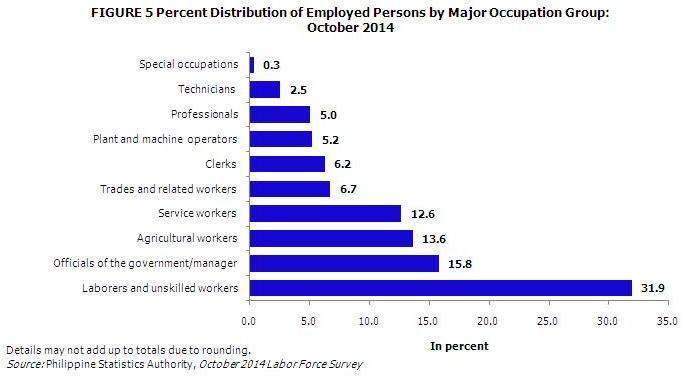
Wage and salary workers comprised about 58.0 percent of the employed population
Employed persons fall into any of these broad categories: (1) wage and salary workers, (2) self-employed without any paid employee, (3) employer in own family-operated farm or business and (4) unpaid family workers. Wage and salary workers were classified further as those who work for private households, private establishments, government and government-controlled corporations and those who work with pay in own family-operated farm or business.
In October 2014, the majority (58.1%) of the total employed persons were wage and salary workers, with the largest proportion (45.0%) working for private establishments. Those working for the government and government-controlled corporations accounted for 7.9 percent of the total employed while those working for private households comprised 4.9 percent.
About 28.2 percent were self-employed without any paid employee, 3.0 percent were employers in own family-operated farm or business, while the unpaid family workers made up 10.7 percent (Table 6).
Among the unpaid family workers, 67.4 percent were working in the agriculture sector. In contrast, the majority (60.7%) of the wage and salary workers were employed in the services sector (Table 7 and Figure 6).

Three in five employed persons were full-time workers
Employed persons are classified as either full-time workers or part-time workers. Full-time workers refer to those who worked for 40 hours or more during the reference week, while those who worked for less than 40 hours were considered part-time workers. Of the total employed persons in October 2014, 63.7 percent or three in every five were full-time workers, while 35.4 percent were part-time workers (Table 8). Among those working full time, 66.0 percent worked for 40 to 48 hours, while 34.0 percent worked for more than 48 hours.
On the average, employed persons worked for 41.2 hours during the reference week (Table 8).
One in every five employed persons desired more hours of work or underemployed
By definition, employed persons who express the desire to have additional hours of work in their present job or to have an additional job, or to have a new job with longer working hours are considered underemployed.
The total number of underemployed in October 2014 was estimated at 7.3 million (Table 2). This corresponds to an underemployment rate of 18.7 percent (Table 1). Fifty-seven percent of the total underemployed were visibly underemployed or those who worked less than 40 hours during the reference week. Meanwhile, underemployed working full time (worked 40 hours or more) accounted for 41.6 percent of the total underemployed. The remaining 1.3 percent were underemployed who did not report for work during the reference week (Table 9).
The largest proportion (42.3%) of underemployed persons was employed in the agriculture sector (42.3%), followed closely by those in the services sector (41.0%). The underemployed persons in the industry sector accounted for the smallest share (16.7%).
Among the visibly underemployed persons, the majority (56.0%) were working in the agriculture sector. In contrast, the underemployed who worked full time were mainly in the services sector (51.7%) (Table 9 and Figure 7).

Unemployment rate at 6.0 percent
In October 2014, the unemployment rate or the proportion of unemployed persons to the labor force was estimated at 6.0 percent (Table 1). The unemployment rate in October 2013 was estimated at 6.4 percent. Among the regions, NCR (9.8%) had the highest unemployment rate, followed by Ilocos Region (7.5%), Central Luzon (7.4%), and CALABARZON (7.1%) (Table 1 and Figure 8).
The majority (65.2%) of the unemployed were males. Almost half (49.4%) of the unemployed persons belong to age group 15 to 24 years, while age group 25 to 34 accounted for 30.2 percent (Table 3).
By educational attainment, 21.6 percent of the unemployed were college graduates, 13.5 percent were college undergraduates, and 33.2 percent were high school graduates (Table 10).

Persons not in the labor force predominantly women
Among the population 15 years old and over in October 2014, 22.9 million or 35.7 percent were not in the labor force. These were mostly housewives, students, persons with disability, and retirees. Seven out of ten (69.8%) persons who were not in the labor force were females.
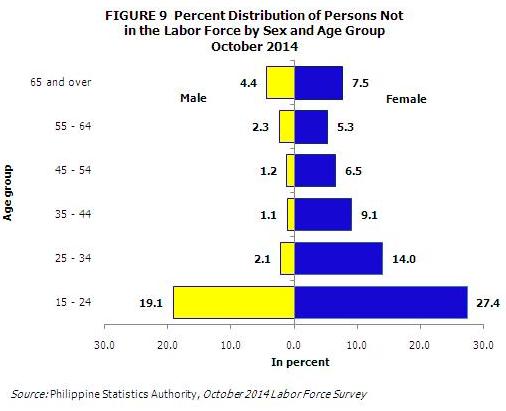
Nearly half (46.5%) of those who were not in the labor force belonged to age group 15 to 24 years (Table 3).
SUMMARY STATISTICS
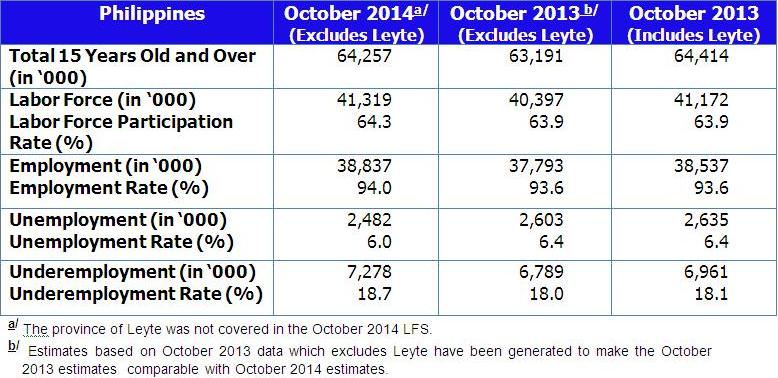
- Of the estimated 64.3 million population 15 years old and over, 41.3 million were in the labor force in October 2014. This translates to a labor force participation rate (LFPR) of 64.3 percent. The LFPR in 2013 of the same period was 63.9 percent.
- LFPR was posted highest in Region X (71.0%) and lowest in ARMM (56.9%).
- The employment rate in October 2014 was estimated at 94.0 percent. It was 93.6 percent in October 2013.
- Majority (53.7%) of the employed persons were in the services sector, 30.8 percent in the agriculture sector and the remaining 15.6 percent in the industry sector.
- Laborers and unskilled workers (31.9%) comprised the largest occupation group, followed by Officials of government and special-interest organizations, corporate executives, managers, managing proprietors and supervisors (15.8%).
- Almost three-fifths (58.1%) of the total employed persons were wage and salary workers; 28.2 percent were self-employed; 3.0 percent were employers in own family-operated farm or business; and 10.7 percent were unpaid family workers.
- Underemployment rate was estimated at 18.7 percent in October 2014. In the same month of 2013, the underemployment rate was 18.0 percent.
- The largest proportion (42.3%) of underemployed persons were working in the agriculture sector.
- Fifty-seven percent (57.0%) of the total underemployed were reported as visibly underemployed or those who worked less than 40 hours during the reference week.
- Unemployment rate in October 2014 was estimated at 6.0 percent. The estimate in October 2013 was 6.4 percent.
- Among the regions, NCR (9.8%) had the highest unemployment rate while lowest was in Region IX (2.9%).
- The majority (65.2%) of the unemployed were males.
- More than one-fifth (21.6%) of the total unemployed were college graduates.
Technical Notes
The Labor Force Survey (LFS) is a nationwide survey conducted quarterly by the Philippine Statistics Authority (PSA) during the months of January, April, July, and October. For this release, the data being presented are based on the final results of the October 2014 round of the LFS.
The reference period used in the survey refers to the past seven (7) days preceding the date of visit of the enumerator. The number of sample households was about 50,000.
The concepts and definitions used in the survey can be found in PSA-ISH Bulletins. Some are given below:
a. Labor Force – refers to the population 15 years old and over who contribute or seek to contribute to the production of goods and services as defined in the system of National Account production boundary. It comprises the employed and unemployed.
b. Employed – refers to persons in the labor force who are reported either as at work or with a job or business although not at work. Persons at work are those who did some work, even for an hour during the reference period.
c. Unemployed – refers to persons in the labor force who are reported as:
1) without work;
2) currently available for work; and
3) seeking work or not seeking work due to the following reasons:
i) belief that no work is available, or
ii) awaiting results of previous job application, or
iii) because of temporary illness or disability, or
iv) bad weather, or
v) waiting for rehire or job recall.
The new definition of unemployed was adopted starting April 2005 per NSCB Resolution No. 15 dated October 20, 2004.
The old definition of unemployed considered only two criteria:
1) Without work and looking for work; or
2) Without work and not looking for work due to reasons cited in 3(i) to 3(v).
d. Underemployed – refers to employed persons who express the desire to have additional hours of work in their present job or an additional job, or have a new job with longer working hours.
e. Labor Force Participation Rate (LFPR) – proportion of total labor force to the total household population 15 years and over.
f. Employment Rate – proportion of employed persons to the total labor force.
g. Unemployment Rate – proportion of unemployed persons to the total labor force.
h. Underemployment Rate – proportion of underemployed persons to total employed persons.
Startting with the July 2003 round, the LFS used the 2003 Master Sample Design. Using this design, the number of sample households is around 50,000 households.
The province of Basilan is included in the ARMM while Isabela City (Basilan) is placed under Region IX, in accordance with Executive Order No. 36.
Starting with the January 2007 LFS round, the population projections based on the 2000 Census of Population and Housing was adopted to generate the labor force statistics. This is in compliance with NSCB Resolution No. 1 series of 2005 entitled “Adoption of the Methodology Used in Generating the 2000 Census of Population and Housing-Based National Population Projections.”
____________________________
1 The province of Leyte was not covered in the October 2014 LFS. In this report, for purposes of comparing with the October 2014 results, the October 2013 labor and employment indicators were computed using the October 2013 LFS data that excludes the province of Leyte.
